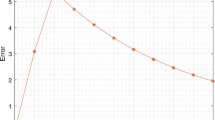Abstract
A fictitious domain approach for the solution of second-order linear differential problems is proposed; spectral/hp elements have been used for the discretization of the domain. The peculiarity of our approach is that the Lagrange multipliers are particular distributed functions, instead of classical \(\delta \) Dirac (impulsive) multipliers. In this paper we present the formulation and the application of this approach to 1D and 2D Poisson problems and 2D Stokes flow (biharmonic equation).





















Similar content being viewed by others
References
Peskin, C.S.: Flow patterns around heart valves: a digital computer method for solving the equations of motion. PhD thesis, Sue Golding Graduate Division of Medical Sciences, Albert Einstein College of Medicine, Yeshiva University (1972)
Glowinski, R., Pan, T.W., Periaux, J.: A fictitious domain method for external incompressible viscous flow modeled by Navier–Stokes equations. Comput. Methods Appl. Mech. Eng. 112(1–4), 133–148 (1994a)
Glowinski, R., Pan, T.W., Periaux, J.: A fictitious domain method for Dirichlet problem and applications. Comput. Methods Appl. Mech. Eng. 111(3–4), 283–303 (1994b)
Glowinski, R., Pan, T.W., Periaux, J.: A Lagrange multiplier/fictitious domain method for the Dirichlet problem—generalization to some flow problems. Japan J. Indust. Appl. Math. 12, 87–108 (1995)
Babuška, I., Guo, B.: The \(h-p\) version of the finite element method. Comput. Mech. 1(1), 21–41 (1986)
Babuška, I., Suri, M.: The \(h-p\) version of the finite element method with quasiuniform meshes. ESAIM Math. Model. Numer. Anal. 21(2), 199–238 (1987)
Karniadakis, G., Sherwin, S.: Spectral/\(hp\) Element Methods for Computational Fluid Dynamics. Oxford University Press, New York (1999)
Pontaza, J., Reddy, J.: Space-time coupled spectral/\(hp\) least-squares finite element formulation for the incompressible Navier-Stokes equations. J. Comput. Phys. 197(2), 418–459 (2004)
Vos, P., Van Loon, R., Sherwin, S.J.: A comparison of fictitious domain methods appropriate for spectral/\(hp\) element discretization. Comput. Methods Appl. Mech. Eng. 197(25), 2275–2289 (2008)
Parussini, L.: Fictitious domain approach for spectral/\(hp\) element method. Comput. Model. Eng. Sci. 17(2), 95–114 (2007)
Parussini, L.: Fictitious domain approach via Lagrange multipliers with least squares spectral element method. J. Sci. Comp. 37(3), 316–335 (2008)
Parussini, L., Pediroda, V.: Fictitious domain with least-squares spectral element method to explore geometric uncertainties by non-intrusive polynomial chaos method. Comput. Model. Eng. Sci. 22(1), 41–64 (2007)
Parussini, L., Pediroda, V.: Investigation of multi geometric uncertainties by different polynomial chaos methodologies using a fictitious domain solver. Comput. Model. Eng. Sci. 23(1), 29–52 (2008)
Glowinski, R., Pan, T.W., Periaux, J.: Distributed Lagrange multiplier method for incompressible viscous flow around moving rigid bodies. Comput. Methods Appl. Mech. Eng. 151(1–2), 181–194 (1998)
Auricchio, F., Boffi, D., Gastaldi, L., Lefieux, A.: On a fictitious domain method with distributed Lagrange multiplier for interface problems. Appl. Numer. Math. 95, 36–50 (2015)
Boffi, D., Cavallini, N., Gastaldi, L.: The finite element immersed boundary method with distributed Lagrange multiplier. SIAM J. Numer. Anal. 53(6), 2584–2604 (2015)
Glowinski, R.: Finite element methods for incompressible viscous flow. In: Handbook of Numerical Analysis, chap 8, vol. 9, pp. 3–1176. North-Holland, Amsterdam (2003)
Dong, S., Liu, D., Maxey, M.R., Karniadakis, G.E.: Spectral distributed Lagrange multiplier method: algorithm and benchmark tests. J. Comput. Phys. 195(2), 695–717 (2004)
Buffat, M., Le Penven, L.: A spectral fictitious domain method with internal forcing for solving elliptic pdes. J. Comput. Phys. 230(7), 2433–2450 (2010)
Moreau, F., Hellou, M., El Yazidi, M.Z.: Ecoulements cellulaires de Stokes dans un canal plan obstrué par une file de cylindres. Angew. Math. Phys. 49(1), 31–45 (1998)
Author information
Authors and Affiliations
Corresponding author
Rights and permissions
About this article
Cite this article
Zamolo, R., Parussini, L. & Pediroda, V. Distributed Lagrange Multiplier Functions for Fictitious Domain Method with Spectral/hp Element Discretization. J Sci Comput 74, 805–825 (2018). https://doi.org/10.1007/s10915-017-0464-1
Received:
Revised:
Accepted:
Published:
Issue Date:
DOI: https://doi.org/10.1007/s10915-017-0464-1




